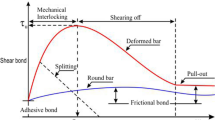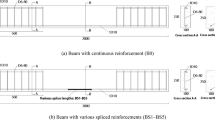Abstract
In this study, nine different types of concrete were adopted: normal concrete (NC) with low slump (68 mm) and eight types of self-compacting concrete (SCC) in which cement was partially replaced by four kinds of replacements (25%, 30%, 35% and 40%) of class F fly ash (FA) and by four kinds of replacements (5%, 10%, 15% and 20%) of silica fume (SF). The main objective of this research was to evaluate the effect of different types and dosages of mineral additions on the moment capacities and stiffnesses of the beam specimens and the bond strength of tension lap-spliced bars embedded in NC and self-compacting concretes (SCCs). To achieve these objectives, 27 full-scale beam specimens (2000 × 300 × 200 mm) were tested. In all beam specimens, 20 mm reinforcing bars were used with a 300 mm splice length as tension reinforcement. The variable used was the amount of FA and SF incorporated into SCC. Each beam was designed with bars spliced in a constant moment region at midspan. The splice length was selected so that bars would fail in bond, splitting the concrete cover in the splice region, before reaching the yield point. Moreover, bond strength of SCC beams was compared to that of NC beams of the same dimensions, steel configuration and approximately the same water-to-cement ratio. In conclusion, the beam specimens produced from SCC containing 5% SF and 30% FA had the highest normalized bond strength with 1.07 whilst the replacements of Portland cement (PC) by an equal weight of FA or SF in SCC had generally the positive effect on the bond strength of reinforcing bar regardless of the dosage of mineral admixture compared to the specimen with NC indicating that SCC due to its superior filling capability more effectively covered the reinforcements and the grain-size distribution and particle packing improved ensuring greater cohesiveness. Moreover, the beam specimens produced from SCC with SF had the greatest stiffness compared to other all beams as result of the improvement of concrete pore structure due to the pozzolanic activity and the filler effect of high fineness silica fume.






Similar content being viewed by others
Abbreviations
- Ab :
-
Tension steel bar area (mm2)
- \( \text{A}_{\text{b}}^{\prime} \) :
-
Compression steel bar area (mm2)
- a:
-
Depth of compression stress block (mm)
- b:
-
Beam width (mm)
- C:
-
Compressive load on the concrete (N)
- d:
-
Effective depth (mm)
- d′:
-
Cover concrete (mm)
- εcu :
-
Ultimate strain in concrete
- εs :
-
Strain in tension steel bar
- \(\epsilon_{\text{s}}^{\prime} \) :
-
Strain in compression steel bar
- \( \text{f}_{\text{c}}^{\prime} \) :
-
28-Day compressive strength of concrete (MPa)
- \( \text{f}_{\text{s}}^{\prime} \) :
-
Tensile stress in compression steel bar (MPa)
- fy :
-
Effective yield strength of rebars (MPa)
- h:
-
Beam depth (mm)
- L:
-
Shear span (mm)
- M1 :
-
The theoretical ultimate moment due to compressive load (Nmm)
- M2 :
-
The theoretical ultimate moment due to the tensile reinforcement (Nmm)
- Pmax :
-
Measured ultimate load (N)
- T′:
-
Tensile load on the top reinforcement (N)
- T1 :
-
Tensile load on the reinforcement due to compressive load (N)
- T2 :
-
Tensile load on the reinforcement due to the compressive reinforcement (N)
- x:
-
Distance from extreme compression fiber to neutral axis (mm)
- z:
-
Distance between the resultant tensile and compressive loads (mm)
- N.A.:
-
Neutral axis
References
Tepfers R (1979) Cracking of concrete cover along anchored deformed reinforcing bars. Mag Concr Res 31(106):3–12
Tepfers R (1973) A theory of bond applied to overlapped tensile reinforcement splices for deformed bars. Chalmers University of Technology, Goteborg
Ozawa K, Maekawa K, Kunishima M, Okamura H (1989) High performance concrete based on the durability design of concrete structures. In: Proceedings East Asia Pacific conference on structural engineering (EASEC 2). Chiang Mai, Thailan, January 1989
Phan TH, Chaouche M, Moranville M (2006) Influence of organic admixtures on the rheological behavior of cement pastes. Cement Concr Res 36(10):1807–1813. doi:10.1016/j.cemconres.2006.05.028
Gomes PCC (2002) Optimization and characterization of high-strength self-compacting concrete. Doctoral Thesis, Universitat Politécnica de Catalunya
Valcuende MO, Parra C, Benlloch J (2005) Permeability, porosity and compressive strength of self-compacting concretes. Mater Constr 55(280):17–25
Sakata S, Maruyama K, Minami M (1996) Basic properties and effects of welan gum on self compacting concrete. In: Bartos PJM, Marrs DL, Cleland DJ (eds) Proceedings of RILEM International conference production methods and workability of concrete. E&FN Spon, London
Lachemi M, Hossain KMA, Lambros V, Nkinamubanzi PC, Bouzoubaa N (2004) Performance of new viscosity modifying admixtures in enhancing the rheological properties of cement paste. Cement Concr Res 34(2):185–193. doi:10.1016/S0008-8846(03)00233-3
Sonebi M (2004) Medium strength self-compacting concrete containing fly ash: modelling using factorial experimental plans. Cement Concr Res 34:1199–1208. doi:10.1016/j.cemconres.2003.12.022
Sonebi M, Bartos PJM (2002) Filling ability and plastic settlement of self-compacting concrete. Mater Struct 35(252):462–469. doi:10.1007/BF02483133
Khayat KH, Bickley J, Lessard M (2000) Performance of self-consolidating concrete for casting basement and foundation walls. ACI Mater J 97(3):374–380
Yahia A, Tanimura M, Shimabukuro A, Shimoyama Y (1999) Effect of rheological parameters on self compactability of concrete containing various mineral admixtures. In: Skarendahl A, Petersson Ö (eds) First RILEM international symposium on self-compacting concrete, Stockholm
Turk K, Caliskan S, Yazicioglu S (2007) Capillary water absorption of self-compacting concrete under different curing conditions. Indian J Eng Mater Sci 14(5):365–372
Ulucan ZC, Turk K, Karatas M (2008) Effect of mineral admixtures on correlation between ultrasonic velocity and compressive strength for self-compacting concrete. Russ J Non-Destr Test 44(5):367–374. doi:10.1134/S1061830908050100
European guidelines for self-compacting concrete: specification, production and use (2005) http://www.efnarc.org/pdf/SCCGuidelinesMay2005.pdf
Gesoglu M, Ozbay E (2007) Effects of mineral admixtures on fresh and hardened properties of self-compacting concretes: binary, ternary and quaternary systems. Mater Struct 40:923–937. doi:10.1617/s11527-007-9242-0
De Almeida Filho FM, El Debs MK, El Debs ALHC (2008) Bond-slip behavior of self-compacting concrete and vibrated concrete using pull-out and beam tests. Mater Struct 41:1073–1089. doi:10.1617/s11527-007-9307-0
De Almeida Filho FM, De Nardin S, El Debs ALHC (2005) Evaluation of the bond strength of self-compacting concrete in pull-out tests. In: Proceedings of the 2nd North American conference on the design and use of self-consolidating concrete and fourth international RILEM symposium on self-compacting concrete. Chicago, 30 October–2 November 2005
Chan YW, Chen YS, Liu YS (2003) Development of bond strength of reinforcing steel in self-consolidation concrete. ACI Struct J 100(4):490–498
Daoud A, Lorrain M, Laborderie C (2003) Anchorage and cracking behaviour of self-compacting concrete. In: Wallevik O, Nielsson I (eds) Proceedings of third RILEM international symposium on self-compacting concrete, Reykjavik Iceland, RILEM Publications, PRO 33, Bagneux, France
Zhu W, Sonebi M, Bartos PJM (2004) Bond and interfacial properties of reinforcement in self-compacting concrete. Mater Struct 37:442–448
Zhu W, Gibbs JC, Bartos PJM (2001) Uniformity of in situ properties of self-compacting concrete in full-scale structural elements. Cement Concr Compos 23(1):57–64. doi:10.1016/S0958-9465(00)00053-6
Turk K, Caliskan S, Yildirim MS (2005) Influence of loading condition and reinforcement size on the concrete/reinforcement bond strength. Struct Eng Mech 19(3):337–346
Hamad BS, Mike JA (2005) Bond strength of hot-dip galvanized reinforcement in normal strength concrete structures. Construct Build Mater 19:275–283. doi:10.1016/j.conbuildmat.2004.07.008
Valcuende M, Para C (2009) Bond behaviour of reinforcement in self-compacting concretes. Construct Build Mater 23:162–170. doi:10.1016/j.conbuildmat.2008.01.007
De Almeida Filho FM (2006) Contribution to study of the bond between steel bars and self-compacting concrete. Doctoral Thesis, Universidade de São Paulo (in Portuguese)
Hamad BS, Seferian ZS (2000) Role of casting position on bond strength of confined tension lap splices in silica fume concrete. Mater Struct 33:584–593. doi:10.1007/BF02480540
Dogangun A (2003) Betonarme yapilarin hesap ve tasarimi. Birsen Yayinevi, İstanbul
Tighiouart B, Benmokrane B, Mukhopadhyaya P (1999) Bond strength of glass FRP rebar splices in beams under static loading. Construct Build Mater 13:383–392. doi:10.1016/S0950-0618(99)00037-9
Domone PL (2007) A review of the mechanical properties of self-compacting concrete. Cement Concr Compos 29:1–12. doi:10.1016/j.cemconcomp.2006.07.010
Hamad BS, Itani MS (1998) Bond strength of reinforcement in high-performence concrete: the role of silica fume, casting position and superplasticizer dosage. ACI Mater J 95(5):499–511
Kjellsen KO, Wallevik OH, Hallgren M (1999) On the compressive strength development of highperformance concrete and paste—effect of silica fume. Mater Struct 32:63–69. doi:10.1007/BF02480414
Goldman A, Bentur A (1993) The influence of microfillers on enhancement of concrete strength. Cement Concr Res 23:962–972. doi:10.1016/0008-8846(93)90050-J
Paulon VA, Dal Molin D, Monteiro PJM (2004) Statistical analysis of the effect of mineral admixtures on the strength of the interfacial transition zone. Interface Sci 12:399–410. doi:10.1023/B:INTS.0000042338.54460.02
Edamatsu Y, Nishida N, Ouchi M (1999) A rational mix-design method for self-compacting concrete considering interaction between coarse aggregate and mortar particles. In: Skarendahl A, Petersson Ö (eds) First RILEM international symposium on self-compacting concrete, Stockholm
Khayat KH (1998) Use of viscosity-modifying admixture to reduce top-bar effect of anchored bars cast with fluid concrete. ACI Mater J 95(2):158–167
Khayat KH (1999) Workability, testing, and performance of self-consolidating concrete. ACI Mater J 96(3):346–353
Sonebi M, Bartos PJM (1999) Hardened SCC and its bond with reinforcement. In: Skarendahl A, Petersson Ö (eds) First RILEM international symposium on self-compacting concrete, Stockholm
ACI 318R-95 (1995) Building code requirements for structural concrete and commentary. American Concrete Institute, PO Box 9094, Farmington Hills, MI 48331, USA
Harajli MH (2004) Comparison of bond strength of steel bars in normal and high-strength concrete. J Mater Civ Eng 16(4):365–374. doi:10.1061/(ASCE)0899-1561(2004)16:4(365)
Esfahani MR, Rangan BV (1998) Bond between normal strength and high strength concrete and reinforcing bars in splices in beams. ACI Struct J 95(3):272–280
Acknowledgement
This research was supported by Firat University Scientific Research Projects Unit (FÜBAP-Project No: 1248).
Author information
Authors and Affiliations
Corresponding author
Rights and permissions
About this article
Cite this article
Turk, K., Karatas, M. & Ulucan, Z.C. Effect of the use of different types and dosages of mineral additions on the bond strength of lap-spliced bars in self-compacting concrete. Mater Struct 43, 557–570 (2010). https://doi.org/10.1617/s11527-009-9511-1
Received:
Accepted:
Published:
Issue Date:
DOI: https://doi.org/10.1617/s11527-009-9511-1




